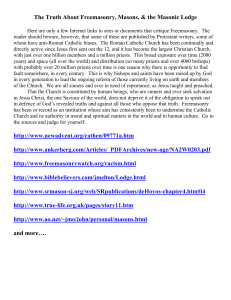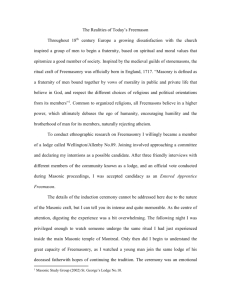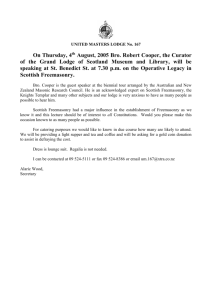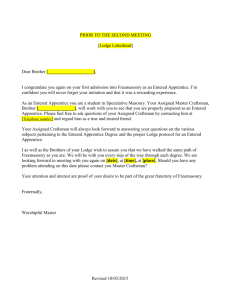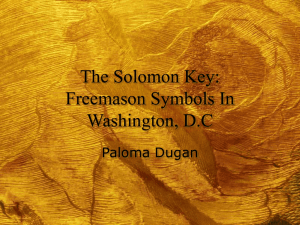Red Triangle - Square of Virtue
advertisement
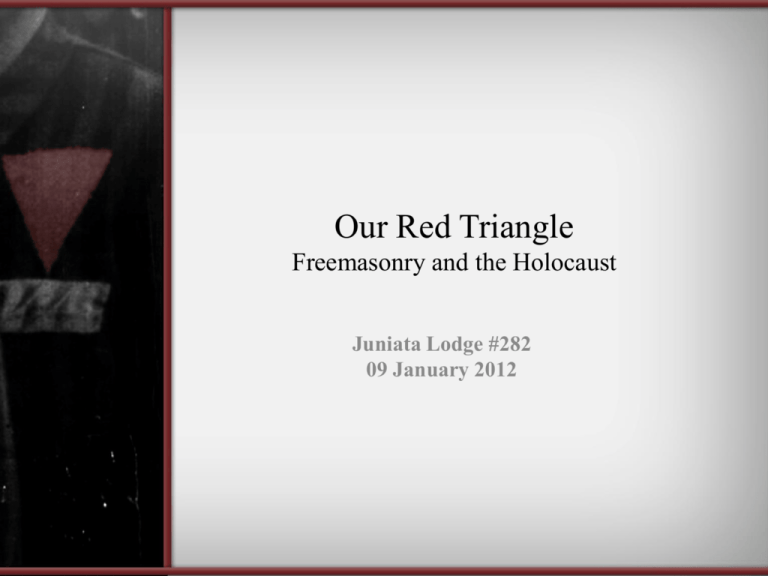
Our Red Triangle Freemasonry and the Holocaust Juniata Lodge #282 09 January 2012 The Holocaust • During the holocaust, between 10 and 11 million citizens were murdered by the Nazis.1 – Jews accounted for approximately 5.7 million2 – An equal number of nonJewish citizens accounted for the rest.3 Germans guard prisoners in the Rovno camp for Soviet prisoners of war. Rovno, Poland, after June 22, 1941. 4 1, 2, 3. Snyder, Timothy (2010). Bloodlands: Europe Between Hitler and Stalin. New York: Basic Book, Timothy Snyder Holocaust: The ignored reality". Eurozine.com 4. http://www.ushmm.org/lcmedia/viewer/wlc/photo.php?RefId=50155 The Holocaust • Among the half non-Jewish citizen victims were: ‒ ‒ ‒ ‒ ‒ ‒ ‒ Gypsies Soviet POW’s Polish and Soviet civilians Homosexuals People with disabilities Jehovah's Witnesses Other political and religious opponents • Freemasons were considered political 1, 2. Niewyk, Donald L. and Nicosia, Francis R. The Columbia Guide to the Holocaust, Columbia University Press, 2000, pp. 45–52. opponents. 2 Why? • An evolution of dislike. • Nazi ideology believes that high degree Masons were willing members of "the Jewish conspiracy“ • Many believed Freemasonry was one of the causes of Germany's loss of the First World War. 1, 2. Hitler, Adolf. Mein Kampf, pp. 315 and 320. Why? • 1925 - Mein Kampf. – A semi autobiographical writing and exposition of Hitler's political ideology – Hitler writes: • "The general pacifistic paralysis of the national instinct of self-preservation begun by Freemasonry is then transmitted to the masses of society by the Jewish press.“1 – In other words: • The Masons and the Jews control the 1. Hitler, Adolf. Mein Kampf, pp. 315 press. and 320. Common Cover of Mein Kampf Hermann Göring • Reichstag President – In 1933 stated: “...in National Socialist Germany, there is no place for Freemasonry”1 • Helped Pass the Enabling Act Hermann Goering in 19322 1. The Annihilation of Freemasonry". Volume LII, No. 206. The American Mercury. February 1941. 2. Photo: http://en.wikipedia.org/wiki/File:Goering1932.jpg The Enabling Act • Passed by Germany's parliament (the Reichstag) on March 23, 1933. • Using the "Act", on January 8, 1934 the German Ministry of the Interior ordered the disbandment of Freemasonry ‒ Confiscation of the property of all Lodges; • Stated that those who had been members of Lodges when Hitler came to power, in January 1933, were prohibited from holding office in the Nazi party or its paramilitary arms, and were ineligible for appointment in public service. • Special sections of the Security Service were established to deal with Freemasonry.1 1. United States Holocaust Memorial Museum, http://www.ushmm.org/wlc/en/article.php?ModuleId=10007187 Freemasonry Banned • In Aug. 1935, Hitler announced in the Nazi Party newspaper the final dissolution of all Masonic Lodges in Germany. ‒ The article accused a conspiracy of the Fraternity and “World Jewry” of seeking to create a “World Republic”.1 • The Ministry of Defense forbid officers from becoming Freemasons, with officers who remained as Masons being sidelined.2 1. Bro. E Howe, Freemasonry in Germany, Quatuor Coronati Lodge, No 2076 (UGLE), 1984 Yearbook. 2. Bessel, Paul M. (November 1994). "Bigotry and the Murder of Freemasonry" Freemasonry Banned • During the war, Freemasonry was banned by edict in all countries that were either allied with the Nazis or under Nazi control, including Norway and France. An antisemitic and anti-Masonic display at the exhibition "Der ewige Jude" (The Eternal Jew), which sought to establish a connection between Jews and Freemasons. Munich, Germany, November 10, 1937.2 Anti-Masonic exhibitions were held 1. . Bessel, Paul M. (November 1994). "Bigotry and the Murder of Freemasonry" 2. http://www.ushmm.org/wlc/en/media_ph.php?ModuleId=10007187&MediaId=5781 in many occupied ‒ Reinhard Heydrich • Counted the Masons, along with the Jews and the political clergy, as the “most implacable enemies of the German race.” • In 1935 argued for the need to eliminate not only the visible manifestations of these “enemies,” but to root out from every German the “indirect influence of the Jewish spirit” -- “a Jewish, liberal, and Heydrich as a SS-Gruppenführer (1940)2 Masonic infectious residue that remains in the unconscious of many, above all in the 1. United States Holocaust Memorial Museum, http://www.ushmm.org/wlc/en/article.php?ModuleId=10007187, 2. Photo: http://en.wikipedia.org/wiki/Reinhard_Heydrich academic and intellectual Sicherheitsdienst • Heydrich created a special section of the SS Security Service to deal specifically with Freemasonry. 1 ‒ Called Sicherheitsdienst or SD for short2 • The SD, like most Nazis, believed that Freemasonry exercised actual political power, shaped public opinion through control of the press, and was thus in a position to provoke war, subversion, and revolution.3 • In 1939 the SD and the Security Police formed the Security Main Office (Reichssicherheitshauptamt; RSHA) and took 1, 2,3 ,4, United States Holocaust Memorial Museum, http://www.ushmm.org/wlc/en/article.php?ModuleId=10007187 Sicherheitsdienst SD personnel in Poland1 1. http://en.wikipedia.org/wiki/Sicherheitsdienst Grading and Classification • The Nazis used triangle badges as part of the system of identification in concentration camps. 1 • Made it easier to identified the reason the prisoners had been placed there.2 • The triangles were made of fabric and were sewn on jackets and trousers of the 1,2,3. http://www.historyplace.com/worldwar2/holocaust/h-dach-early.htm 3 Grading and Classification http://en.wikipedia.org/wiki/Nazi_concentration_camp_badges Grading and Classification • Freemasons were graded as political prisoners and wore an inverted red triangle.1 1. Katz. "Jews and Freemasons in Europe". In Israel Gutman. The Encyclopedia of the Holocaust. p. vol. 2, p. 531. Concentration Camps • Freemasonry persisted even in the face of genocide. • Evidence of at least two lodges were found to have existed inside the walls of Nazi concentration camps.1,2 ‒ Beloved Liberty Inmates at Esterwegen.5 1,3,4, 5. http://en.wikipedia.org/wiki/Loge_Loge_Liberté_chérie 2,3. http://en.wikipedia.org/wiki/Esterwegen. 2. http://en.wikipedia.org/wiki/Jean_Rey_(politician)3. http://en.wikipedia.org/wiki/Obstinée Beloved Liberty Lodge • Liberté Chérie or Beloved Liberty Lodge was one of very few lodges founded inside a Nazi concentration camp.1 • Established inside Hut 6 at Esterwegen.2 ‒ Prisoner camp used mainly for political prisoners2 • Founded November 1943 by 7 Belgian Freemasons and resistance fighters.3 • Entered, Passed, and Raised at least 2 additional members.4 1,2,3,4. http://en.wikipedia.org/wiki/Loge_Loge_Liberté_chérie Beloved Liberty Lodge • The Brethren met for lodge work in Hut 6 around a table, which was otherwise used for cartridge sorting. 1 • A Catholic Priest stood watch, so that the Brethren could hold their meetings; and protected their secrecy.2 • Members described initiation, etc., as just as simple ceremonies. “Ceremonies took place at one of the tables after a very highly simplified ritual - whose individual 1,2,3.http://en.wikipedia.org/wiki/Loge_Loge_Liberté_chérie components were however explained to the initiate; ‒ Beloved Liberty Lodge • Memorial raised by Belgian and German CoFreemasons on Saturday November 13, 2004.1 • It is now part of the memorial site of the Esterwegen Cemetery2 1,2. http://en.wikipedia.org/wiki/Loge_Loge_Liberté_chérie Obstinate Lodge • L'Obstinée was another Masonic Lodge founded inside the walls of a Nazi prisoner-ofwar camp.1 ‒ Oflag X-D prisoner-of-war camp near Hamburg.2 • Founded by members of the Grand Orient of Belgium.3 • The Grand Orient of Belgium would recognize the Lodge on 14 July 1946.4 1,2,3,4. http://en.wikipedia.org/wiki/ Obstinée How Many Deaths? • The number of Freemasons from Nazi occupied countries who were killed is not accurately known ‒ ‒ It is estimated that between 80,000 and 200,000 Freemasons were murdered under the Nazi regime.1,2 Many Freemasons were also Jewish, so accurate numbers are hard to distinguish. 1. Freemasons for Dummies, by Christopher Hodapp, Wiley Publishing Inc., Indianapolis, 2005, p.85, sec. Hitler and the Nazi 2. http://www.grandlodgescotland.com The Forget-Me-Not • The small blue forget-me-not flower was first used by the Grand Lodge Zur Sonne, in 1926, as a Masonic emblem at the annual convention in Bremen, Germany.1 Bernheim, Alain (2004-09-10). "The Blue Forget-Me-Not": Another Side Of The Story". Pietre-Stones Review of Freemasonry. The Forget-Me-Not • The Nazis used it as a different symbol. • The Winterhilfswerk (Winter Relief) was an annual drive by a Nazi welfare organization to help finance charitable work from 1933-1945.1,2 • Ironically, its slogan was "None shall starve nor freeze"., and was designed to 1935/1936 Winterhilfswerk Poster provide food, clothing, coal, and other items to less 1,2, 3 http://www.sovietstores.com/third-reich-day-badges/ww2-german-winterhilfswerk-flower-pink-and-blue . 4. http://en.wikipedia.org/wiki/Winterhilfswerk fortunate Germans during the 4 The Forget-Me-Not • In 1938 the forget-me-not badge was chosen by the Nazis as a symbol for the event.1 • It is said that the pin was made by the same factory that manufactured a Masonic badge.2 • It is also rumored that this coincidence enabled Pin from the Winterhilfswerk event some Freemasons to wear the forget-me-not as a 1,2. http://www.sovietstores.com/third-reich-day-badges/ww2-german-winterhilfswerk-flower-pink-and-blue . secret sign of 3, http://en.wikipedia.org/wiki/Freemasonry The Forget-Me-Not • But, Is it true? ‒ ‒ ‒ The use of the pin by interred Freemasons is debated. Although plausible, there is no documented evidence that it was used as an identifying mark for captive Masons. Even if this is not the case, this legend quickly placed the forget-me-not in an important position in Masonic history. The Forget-Me-Not • After World War II, the forget-me-not flower was again used as a Masonic emblem at the first Annual Convention of the United Grand Lodges of Germany in 1948. 1 • The badge is now worn in the coat lapel by Freemasons around the world to remember all those that have suffered in the name of Freemasonry, especially 1. Bernheim, Alain (2004-09-10). "The Blue Forget-Me-Not": Another Side Of The Story". Pietre-Stones Review of those during the Nazi Freemasonry. 2. http://www.freemasons-freemasonry.com/bernheim3.html . 2 Why Should I Care? • It happened! • In another time, this could have been us. • Remembering history assures we don’t repeat it. Juniata Lodge #282 – Our Red Triangle THANK YOU!
